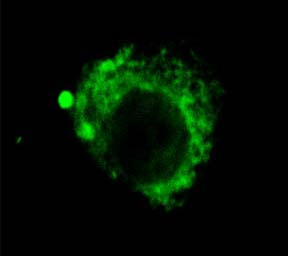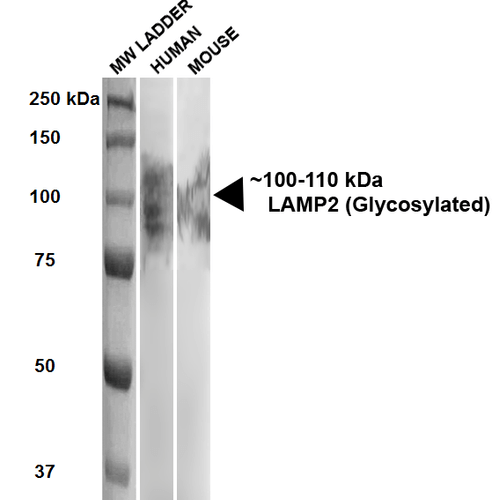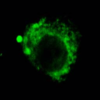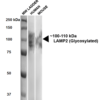Anti-LAMP2 Antibody (56272)
$448.00
SKU: 56272
Categories: Antibody Products, Cell Adhesion Molecule Antibodies, Products
Overview
Product Name Anti-LAMP2 Antibody (56272)
Description Anti-LAMP2 Antibody Rat Monoclonal Antibody
Target LAMP2
Species Reactivity Mouse, Rabbit
Applications WB,ICC/IF,IP
Host Rat
Clonality Monoclonal
Clone ID GL2A7
Isotype IgG1
Immunogen Gluteraldehyde-fixed mouse liver lysosomes
Properties
Form Liquid
Concentration Lot Specific
Formulation PBS, pH 7.4.
Buffer Formulation Phosphate Buffered Saline
Buffer pH pH 7.4
Format Purified
Purification Purified by Protein G affinity chromatography
Specificity Information
Specificity This antibody recognizes human, mouse, and rabbit LAMP2 (~100-110 kDa).Accession no.: NP_001017959.1 Gene ID: 16784
Target Name Lysosome-associated membrane glycoprotein 2
Target ID LAMP2
Uniprot ID P17047
Alternative Names LAMP-2, Lysosome-associated membrane protein 2, CD107 antigen-like family member B, Lysosomal membrane glycoprotein type B, LGP-B, CD antigen CD107b
Gene Name Lamp2
Sequence Location Cell membrane, Endosome membrane, Cytoplasmic vesicle, autophagosome membrane, Lysosome membrane
Biological Function Plays an important role in chaperone-mediated autophagy, a process that mediates lysosomal degradation of proteins in response to various stresses and as part of the normal turnover of proteins with a long biological half-live (PubMed:10972293). Functions by binding target proteins, such as GAPDH and MLLT11, and targeting them for lysosomal degradation (By similarity). Required for the fusion of autophagosomes with lysosomes during autophagy (PubMed:27628032). Cells that lack LAMP2 express normal levels of VAMP8, but fail to accumulate STX17 on autophagosomes, which is the most likely explanation for the lack of fusion between autophagosomes and lysosomes (PubMed:27628032). Required for normal degradation of the contents of autophagosomes (PubMed:10972293, PubMed:12221139). Plays a role in lysosomal protein degradation in response to starvation (PubMed:27628032). Required for efficient MHCII-mediated presentation of exogenous antigens via its function in lysosomal protein degradation; antigenic peptides generated by proteases in the endosomal/lysosomal compartment are captured by nascent MHCII subunits. Is not required for efficient MHCII-mediated presentation of endogenous antigens (By similarity). {UniProtKB:P13473, UniProtKB:P17046, PubMed:10972293, PubMed:12221139, PubMed:27628032}.
Research Areas Cell adhesion
Background Lysosome-associated membrane proteins (LAMP1 and LAMP2) are major constituents of the lysosomal membrane. These two proteins have closely related structures with 37% sequence homology. Both are transmembrane glycoproteins localized primarily in lysosomes and late endosomes. LAMP2 has also been detected at the plasma membrane of cells undergoing differentiation and activation and in cells that secrete lysosomal hydrolases. Cell surface LAMP1 and LAMP2 promote adhesion of human peripheral blood mononuclear cells (PBMC) to vascular endothelium which suggests that the LAMP proteins are involved in adhesion of PBMC to sites of inflammation. Defects in LAMP2 are associated with Danon disease.
Application Images



Description Immunocytochemistry/Immunofluorescence analysis using Rat Anti-LAMP2 Monoclonal Antibody, Clone GL2A7 (56272). Tissue: Corneal Endothelial Cell (CEC). Species: Rabbit. Primary Antibody: Rat Anti-LAMP2 Monoclonal Antibody (56272) at 1:1000. Secondary Antibody: FITC Goat Anti-Rat (green). Courtesy of: Eunduck E.P. Kay, Doheny Eye Institute.

Description Western Blot analysis of Human, Mouse HEK293 and 3T3NIH cell lysates showing detection of ~100-110 kDa LAMP2 protein using Rat Anti-LAMP2 Monoclonal Antibody, Clone GL2A7 (56272). Lane 1: MW ladder. Lane 2: Human HEK293 lysate (20 µg). Lane 3: Mouse 3T3NIH lysate (10 µg). Block: 5% milk + TBST for 1 hour at RT. Primary Antibody: Rat Anti-LAMP2 Monoclonal Antibody (56272) at 1:500 for 1 hour at RT. Secondary Antibody: HRP Goat Anti-Rat at 1:100 for 1 hour at RT. Color Development: TMB solution for 5 min at RT. Predicted/Observed Size: ~100-110 kDa.
Handling
Storage This antibody is stable for at least one (1) year at -20°C.
Dilution Instructions Dilute in PBS or medium which is identical to that used in the assay system.
Application Instructions Immunoblotting: Use at 1-2ug/mL. A band of ~100-110kDa (glycosylated) is detected.
Immunofluorescence: Use at 1-2ug/mL. This antibody labels lysosomes and late endosomes in cells permeabilized with saponin.
These are recommended concentrations.
Enduser should determine optimal concentrations for their application.
Immunofluorescence: Use at 1-2ug/mL. This antibody labels lysosomes and late endosomes in cells permeabilized with saponin.
These are recommended concentrations.
Enduser should determine optimal concentrations for their application.
References & Data Sheet
Data Sheet  Download PDF Data Sheet
Download PDF Data Sheet
 Download PDF Data Sheet
Download PDF Data Sheet





